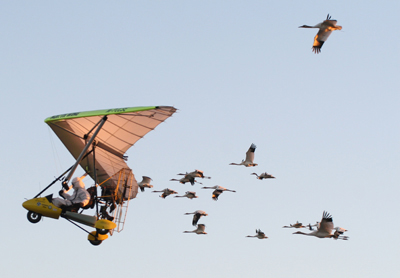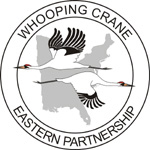| Media Contact: Joan Garland, ICF Outreach Coordinator, 608-381-1262
The nine Whooping Cranes will be placed in travel enclosures and loaded onto vehicles as soon as possible. They will be driven about 70 miles from Winston County, Ala., to Wheeler NWR. The cranes will be temporarily housed in a secure pen, during which time they will be fitted with identification bands and tracking transmitters. The young birds will then be released in the company of other Whooping Cranes that have been wintering at the refuge. These nine juvenile cranes are the 11th group to be guided south by ultralight aircraft from Wisconsin. The Whooping Crane Eastern Partnership (WCEP), an international coalition of public and private organizations, is conducting the reintroduction project in an effort to restore this endangered species to part of its historic range in eastern North America. There are approximately 111 Whooping Cranes in this population thanks to WCEP’s efforts. The cranes were intended to spend the winter at St. Marks and Chassahowitzka National Wildlife Refuges along Florida’s Gulf Coast. The migration had been delayed for over a month due to weather and an issue involving FAA flying policies. The FAA granted a waiver for the flight, but the cranes apparently decided that Alabama was far enough, refusing to follow the ultralights any further. “We are fortunate to be in a position to help by standing in for our sister refuges at Chassahowitzka and St. Marks in Florida,” said Dwight Cooley, refuge manager for Wheeler NWR. “While we hope the cranes will visit us again in coming winters, where they eventually winter is not nearly as important as their survival, and the hope that they will complete many more migrations in years to come. Their continued safety is our highest concern. We’ve got great habitat and conditions, as evidenced by the number of cranes wintering on the refuge–more than 11,000 Sandhill Cranes and seven Whooping Cranes.” In addition to the nine birds led south by project partner Operation Migration’s ultralights, eight juvenile cranes made their first southward migration this fall as part of WCEP’s Direct Autumn Release program. Biologists from the International Crane Foundation released the cranes in the company of older cranes at Horicon NWR in Dodge County, Wis. The young birds learned the migration route by following the older cranes. Whooping Cranes that take part in the ultralight and Direct Autumn Release reintroductions are hatched at the U.S. Geological Survey’s Patuxent Wildlife Research Center in Laurel, Md., and at the International Crane Foundation in Baraboo, Wis. Chicks are raised under a strict isolation protocol and to ensure the birds remain wild, handlers adhere to a no-talking rule and wear costumes designed to mask the human form. Most of the Whooping Cranes released in previous years spend the summer in central Wisconsin, where they use areas on or near Necedah NWR, as well as other public and private lands. In the spring and fall, project staff from the International Crane Foundation and the Wisconsin Department of Natural Resources track and monitor the released cranes in an effort to learn as much as possible about their unassisted journeys and the habitat choices they make both along the way and on their summering and wintering grounds. Whooping Cranes were on the verge of extinction in the 1940s. Today, there are only about 600 birds in existence, approximately 450 of them in the wild. Aside from the 111 WCEP birds, the only other migrating population of Whooping Cranes nests at Wood Buffalo National Park in northern Alberta, Canada and winters at Aransas NWR on the Texas Gulf Coast. A non-migrating flock of approximately 20 birds lives year-round in the central Florida Kissimmee region, and an additional 19 non-migratory cranes live in southern Louisiana. WCEP asks anyone who encounters a Whooping Crane in the wild to please give them the respect and distance they need. Do not approach birds on foot within 200 yards; remain in your vehicle; do not approach in a vehicle within 100 yards. Also, please remain concealed and do not speak loudly enough that the birds can hear you. Finally, do not trespass on private property in an attempt to view or photograph Whooping Cranes. Whooping Crane Eastern Partnership founding members are the International Crane Foundation, Operation Migration, Inc., Wisconsin Department of Natural Resources, U.S. Fish and Wildlife Service, the U.S. Geological Survey’s Patuxent Wildlife Research Center and National Wildlife Health Center, the National Fish and Wildlife Foundation, the Natural Resources Foundation of Wisconsin, and the International Whooping Crane Recovery Team. Many other flyway states, provinces, private individuals and conservation groups have joined forces with and support WCEP by donating resources, funding and personnel. More than 60 percent of the project’s budget comes from private sources in the form of grants, public donations and corporate sponsors. |  Learn more about ICF’s commitment to the endangered Whooping Crane. Share this video with your friends and help us spread the word that disturbing, harassing or killing Whooping Cranes is a crime.
Make a gift to support Whooping Crane conservation. |



